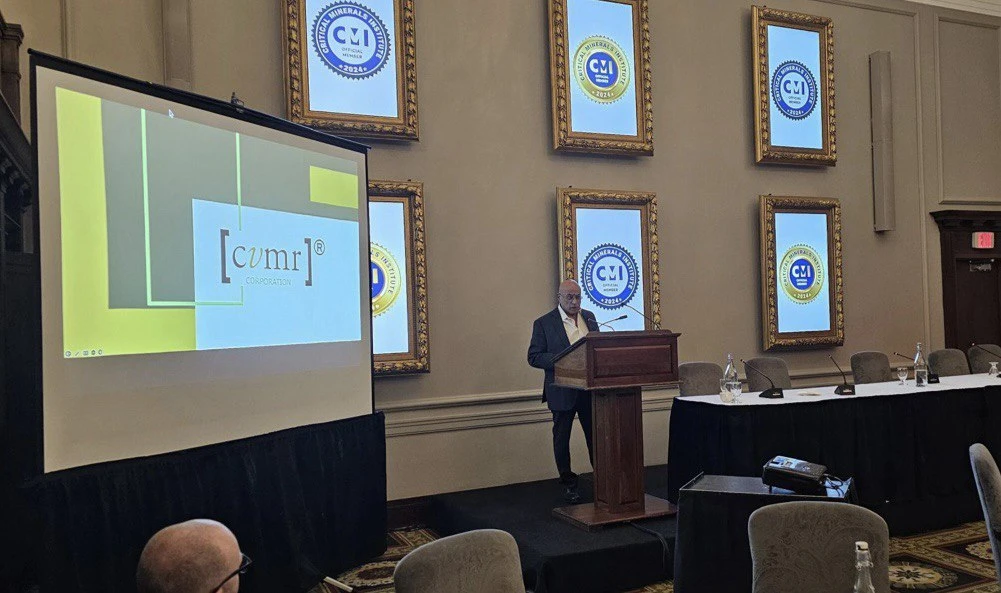Leviathan of Nano Metal Powders and 3D & 4D Printing
Table of contents
Leviathan of Nano Metal Powders and 3D & 4D Printing
He looked at me with his penetrating gaze, through his gold rimmed glasses, as he removed his cigar from his mouth, puffed the smoke into the air, and said with a hybrid, English accent, ‘One of the rare privileges we have in Canada is the ability to smoke a good Havana, legally.’ Kamran M. Khozan or Mr. K, as he is known to his employees around the world, is the Chairman and CEO of CVMR® Corporation, a multinational, privately held, mining, metal refining and metal powder manufacturing conglomerate spread over 18 countries. The company spends large sums on R&D and has managed to invent technologies that are state of the art in vapour metallurgy.
Mr. K is also the head of a number of financial institutions, a power generating equipment inventor and manufacturing company, security equipment manufacturing and a graphite and graphene research facility. He manages his family’s charity organization and a number of other manufacturing and technology development companies in North America, Europe and the Far East. He is not a typical businessman. He is a self-made, self-effacing man, famous for being generous with his time and money. He is truly an eccentric industrialist, a leviathan in his field.
| Kamran M. Khozan is in his early 60s, his close-cropped hair is turning gray with a gray, almost white, trimmed beard and gold-rimmed glasses, he looks like a well-fed archaeologist, ready to start a dig in the jungles of Central America. He often Sports khaki outfits that conjure up images of early 20th century safaris in Africa. He is sitting on an antique English leather chesterfield in his study at his home by the Georgian Bay in Ontario. I am sitting across the room facing him. There is a soft, haunting melody by Miles Davis wafting through the house, and a large Rhodesian Ridgeback, named Sasha, dozing off at his feet. ‘He is an old dog now, not unlike myself. I never trained him; he is as wild as he can be in an urban setting,’ Mr. K feels the need to explain, because, I think, Sasha was barking and threatening me when I arrived at the house. |
We are surrounded by books and works of art in Mr. K’s study. Among them quite a few paintings by renowned artists such as Chagall, Emily Carr, Tom Thomson and Constable, tastefully arranged, pointing to the eclectic taste of their owner. There is a cello in the corner of the study. When I look at it, he immediately follows the direction of my gaze and pipes up, ‘I would not dare play that unforgiving instrument in the presence of anyone, not even my dog can tolerate my sawing on that thing. I should be arrested for attempting it.’ He retracts by adding, ‘I am a bit better on the drums!’
He controls the conversation, moves away from personal to business matters, almost abruptly, ‘I believe US will continue to hold its industrial leadership and with the new inventions in manufacturing, it will be miles ahead of all other nations in the years to come. Economists and Financiers emphasize market size, GDPs, budget deficits and natural resources because they do not understand technology and innovation. They are wrong, as always. Don’t look at the populated spots and who can manufacture gadgets cheaply, instead look at where new ideas are generated. There you will find the source of growth and prosperity. I want to be part of the industrial force that introduces new ideas and changes the way we produce things, the way we work, the way we live. That is why I live and work in North America’
Nanopowders, Graphene, 3D & 4D Printing
I have come to interview Kamran M. Khozan about a new, ambitious project he has initiated in the United States. He plans to manufacture high value, state of the art, nickel, iron, cobalt, tantalum, vanadium, titanium and platinum powders, nano powders and other exotic products for the high tech industry in the United States. He intends to produce graphene by Chemical Vapour Deposition, and to make mobile power generators made of graphite.
‘Nanotechnology and nano products are the way of the future. Combine nano metal powders with the capabilities of Chemical Vapour Deposition, Additive Manufacturing, 3D and 4D Printing and you will catapult the manufacturing world and the way we all live into a different, completely new phase. Imagine the possibilities these new technologies have in store for us in all walks of life.’ His eyes brighten up when he talks about his company’s new inventions and their effect on various industries.
‘We, at CVMR®, are used to fundamental research and innovation and have a high threshold for “Creative Destruction” à la Joseph Schumpeter. We often go through a process of industrial mutation that constantly changes the technological and economic structure of what we do; destroying the old ones and incessantly creating new ones.’
CVMR® has been producing nanopowders of various metals since 1999. The company is considered one of the pioneers of this technology. Today the market for metal powders and nano powders has quite a high growth rate. Estimates range from 18% to 26%. The current market size is estimated to be around $16 billion per annum. Metal powders and nano powders are extensively used in such diverse industries as the automotive, aerospace, personal care, electronics and a variety of consumer goods from canned foods and vitamins to beauty products, computers and jet engines. Metal oxide nanopowders, due to their outstanding magnetic, optical, catalytic, and electronic properties are used extensively in almost every industry imaginable. They are used in coatings, composites, paints, sunscreens, security and defense related equipment, medical instruments and pharmaceuticals.
Iron nanoparticles for example are used in treatment of cancer, magnetic storage and magnetic resonance imaging (MRI). Rare earth nanoparticles and rare earth oxide nanopowders have varied uses, from enhancing fiber optic amplification (EDFA) to the removal of phosphates from blood. Metal oxide nanopowders have far reaching uses in ceramics, electronics, high speed computing, telecommunication and aerospace. They are used as catalysts, sensors, optoelectronic materials and utilized for environmental remediation.
The 4th Dimension!
| We are all familiar with 3D Printing. Its genesis can be traced back to early 1970s, used for rapid prototyping, mostly using plastics of various kinds. The new wave of fascination with this technology is the fact that we can now use this technology to produce metal objects. Today, 70% of a modern car’s metal parts are made with alloys of various metal powders. |
Mr. K adds with great excitement that, ‘There is another major surprise in store for us all, and that is 4D Printing. 3D refers to the three dimensional objects. Now, if you add the time dimension to it, you will have objects that can remember the shapes they were programmed for and change their current shape to suit changing conditions or requirements. For this to happen you will need a source of energy such as sunlight, electricity, gravity, magnetic force, kinetic energy, or a medium such as water or other liquids. A number of US based universities such as MIT, have carried out fascinating research on this, so has CVMR®. Imagine a water pipe, or a sewer system that expands and contracts as required, just like one’s intestine. Imagine objects that can be packaged as wires or sheets that when put under a light source or connected to electricity take a voluminous shape to themselves, such as a box, frame of a fridge, or a chair, etc. Imagine how much money is saved just in shipping costs. In other words, we can now create non-living objects that can change their shape over time without an engine, software or a separate device. They change at their own volition according to a precise memory programed into the structure of the objects themselves. They reshape, assemble or disassemble themselves over time. All you have to do is to add energy.’
These inventions will affect our daily lives. Imagine self-assembling furniture that arrives at your door as a rolled up sheet of metal, with a sticker that reads no assembly required! Imagine if water and sewer pipes could expand or contract to change their capacity or change their flow rate; or maybe undulate like peristaltics to move the water by themselves. There would be no need for expensive pumps or valves; these would be completely programmable and adaptive pipes, doing what they are programmed to do on their own.
The basis of 4D printing process is clever coding that can create ‘smart objects’ which can self-assemble or rearrange themselves to adapt to their environment and the needs of their user. The code can change an object’s angles, color, dimensions, and even alter how it will react to water, movement or fluctuations in temperature.
This technology could dramatically change the manufacturing processes of many standard products, and could even make it easier to build in extreme environments. Car tires could be printed using 4D printing technology, allowing them to change shape and adapt to wet road conditions before shrinking back to their original form when the road surface is dry. The possibilities are endless, and we are only starting to realize the potential this technology will have on everything from education to manufacturing to healthcare to civil engineering.
Although not commercially available, self-assembly is just the beginning of a whole innovative world of manufacturing with minimum energy. As environmental, economic, human and other constraints continue to fluctuate, we will eventually need dynamic systems that can respond with ease and agility. 4D Printing is the first of its kind to offer this exciting capability. ‘This is truly a radical shift in our understanding of structures, which have up to now remained static and rigid, like a car or an office building. All these shapes can become dynamic, adaptable and programmable for on-demand performance, such as sudden change in road conditions, earthquakes or hot or cold weather.’ Kamran M. Khozan elaborates.
Mr. K is a published author, inventor, entrepreneur, art historian, raconteur and wealthy man with a rich mind that is focused on nanoparticles. Watch him influence and maybe direct an important technological market in the coming years.
Source from Hedge Fund Blogs From HedgeCo.Net


Read also




